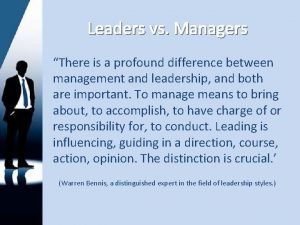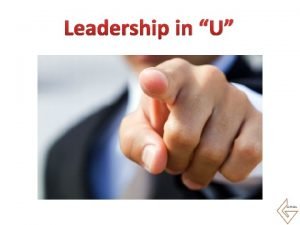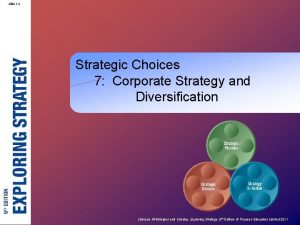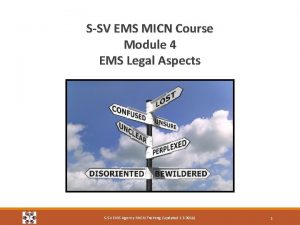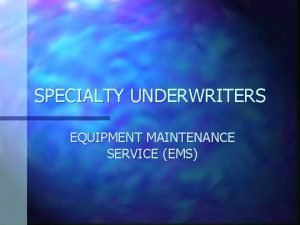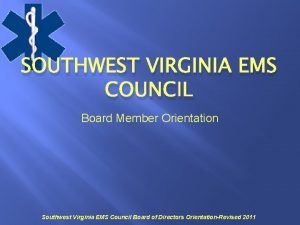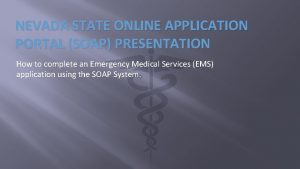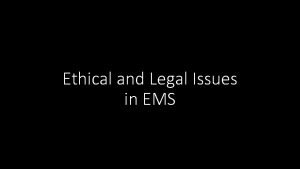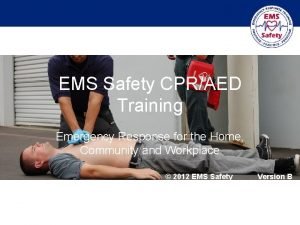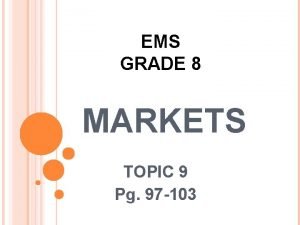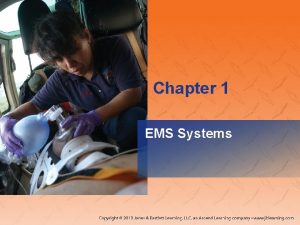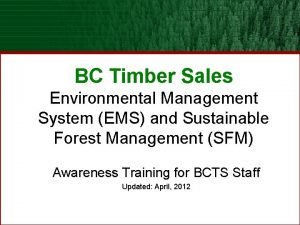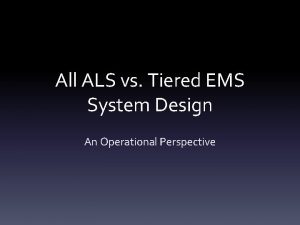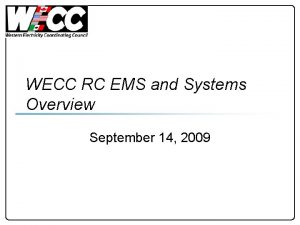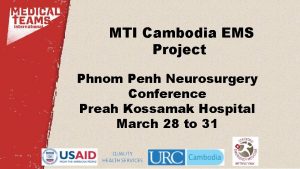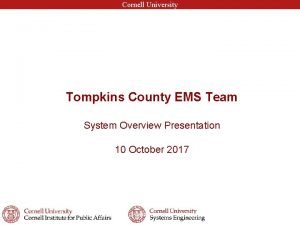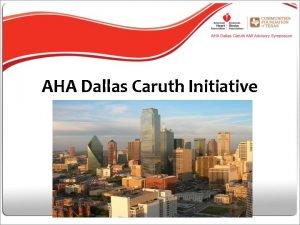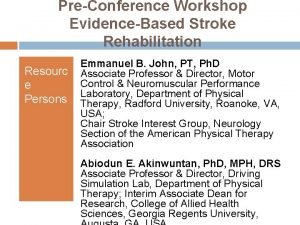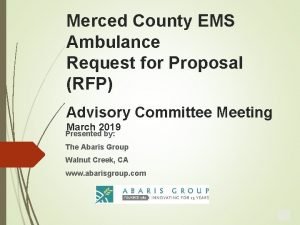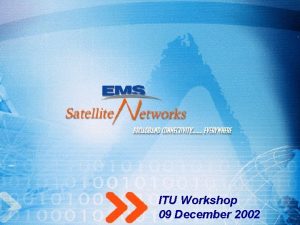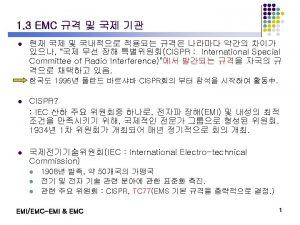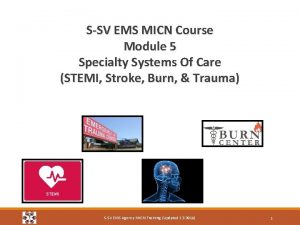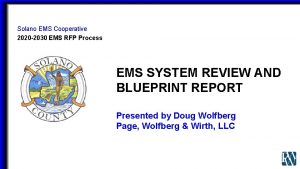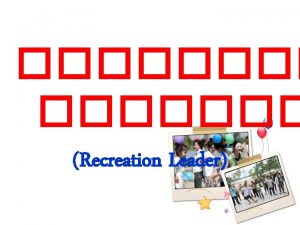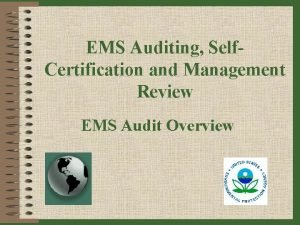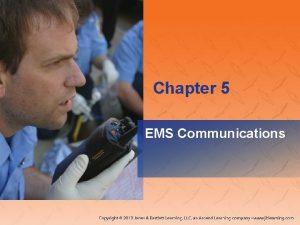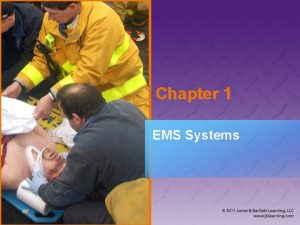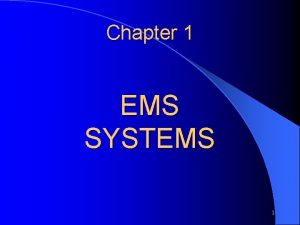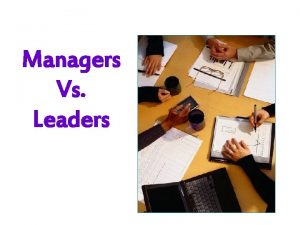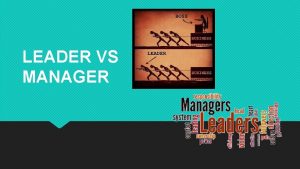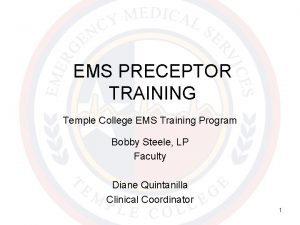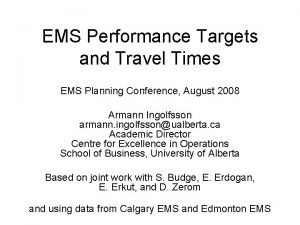Management of EMS 3 CHAPTER Manager to Leader



























































- Slides: 59

Management of EMS 3 CHAPTER Manager to Leader

Learning Objectives 3. 1 Define the difference between management and leadership. 3. 2 Identify the skills needed to be an EMS manager. 3. 3 Identify the management processes and sentinel events in EMS operations. 3. 4 Develop and define leadership activities and roles. Bruce E. Evans • Jeff T. Dyar — Management of EMS Copyright © 2010 by Pearson Education, Inc. Upper Saddle River, NJ 07458

Learning Objectives (Cont. ) 3. 5 Understand how to create vision and values statements. 3. 6 Apply the concept of values to organizational leadership. 3. 7 Understand apply the principles of mentoring and coaching to EMS workers. Bruce E. Evans • Jeff T. Dyar — Management of EMS Copyright © 2010 by Pearson Education, Inc. Upper Saddle River, NJ 07458

Management • Management is a function that focuses on the delivery of good emergency medical services and patient care • Management must understand what the mission of the organization is • Managers and leaders are needed to ensure that EMS personnel remain motivated and efficient at the services they provide Bruce E. Evans • Jeff T. Dyar — Management of EMS Copyright © 2010 by Pearson Education, Inc. Upper Saddle River, NJ 07458

Mission Statement • Written document that provides a basis for the organization's actions and galvanizes decision making so that there is consistency, whether the decisions are those of employees or managers • Management should align itself with the mission Bruce E. Evans • Jeff T. Dyar — Management of EMS Copyright © 2010 by Pearson Education, Inc. Upper Saddle River, NJ 07458

Values Statement • Written description of the beliefs, principles, and ethical guidelines that directs an EMS organization’s planning and operations • Should reflect what the organization and leadership believes and what they are trying to do • Helps promote the culture of the organization Bruce E. Evans • Jeff T. Dyar — Management of EMS Copyright © 2010 by Pearson Education, Inc. Upper Saddle River, NJ 07458

Culture • Culture is a pattern of behavior that helps remove uncertainty for employees and provides a context for doing the organization's work • Provides employees with cues that guide them in performing their functions Bruce E. Evans • Jeff T. Dyar — Management of EMS Copyright © 2010 by Pearson Education, Inc. Upper Saddle River, NJ 07458

Culture (Cont. ) • The values, beliefs, and assumptions that underlie the organization's culture, coupled with the strength of that culture, will determine whether or not an organization will successfully continue to meet the challenges posed by the environment Bruce E. Evans • Jeff T. Dyar — Management of EMS Copyright © 2010 by Pearson Education, Inc. Upper Saddle River, NJ 07458

Culture (Cont. ) • Pattern of artifacts, behaviors, values, beliefs, and underlying assumptions • Leaders and managers often set the stage for culture by establishing the mission, vision, and goals that give the organization direction Bruce E. Evans • Jeff T. Dyar — Management of EMS Copyright © 2010 by Pearson Education, Inc. Upper Saddle River, NJ 07458

Pros and Cons of Culture • Pros: – Strong culture implies uniformity or consensus among all organizational members; as a culture matures, it becomes stronger and leads to greater uniformity of behavior – Among the pros of strong culture are: § Improved communications and diminished need for bureaucratic rules and autocratic controls Bruce E. Evans • Jeff T. Dyar — Management of EMS Copyright © 2010 by Pearson Education, Inc. Upper Saddle River, NJ 07458

Pros and Cons of Culture (Cont. ) • Cons: – Strong culture may also encourage stagnation, narrow-mindedness, and the "not invented here" or "we never do it that way" syndrome in which employees are uninterested in or "feel threatened" by external ideas Bruce E. Evans • Jeff T. Dyar — Management of EMS Copyright © 2010 by Pearson Education, Inc. Upper Saddle River, NJ 07458

Pro’s and Con’s of Culture (Cont. ) • Cons: – These characteristics can lead to the death of an organization – Groupthink can often set in as managers feel the environment cannot sustain debate and is intolerant of other ideas Bruce E. Evans • Jeff T. Dyar — Management of EMS Copyright © 2010 by Pearson Education, Inc. Upper Saddle River, NJ 07458

Five Bases of Power • Reward power – Employees believe their manager will reward them for compliance and for performing various tasks • Coercive power – Employees believe that a manager can deliver punishments when they do not conform to the manager's directives Bruce E. Evans • Jeff T. Dyar — Management of EMS Copyright © 2010 by Pearson Education, Inc. Upper Saddle River, NJ 07458

Five Bases of Power (Cont. ) • Legitimate power – Employees believe that managerial positions automatically afford managers certain rights and authorities • Expert power – Employees believe that the manager has specialized knowledge or skills to accomplish goals and objectives Bruce E. Evans • Jeff T. Dyar — Management of EMS Copyright © 2010 by Pearson Education, Inc. Upper Saddle River, NJ 07458

Five Bases of Power (Cont. ) • Referent power – Employees identify with and respect their manager Bruce E. Evans • Jeff T. Dyar — Management of EMS Copyright © 2010 by Pearson Education, Inc. Upper Saddle River, NJ 07458

Basic Management Skills • Seven essential skills to help ensure success in a manager-leader position: – Keen perception – Broad-based knowledge – Critical thinking – Mature judgment – Clear communication – Common sense – Ethical conduct Bruce E. Evans • Jeff T. Dyar — Management of EMS Copyright © 2010 by Pearson Education, Inc. Upper Saddle River, NJ 07458

What Employees Need and Want • Goal attainment and teamwork require people who can think and follow direction • Strong leadership empowers followers • A leader will acknowledge a different opinion, accept constructive criticism, and recognize that differences of opinion will crop up • Followers understand that stress is an operational distracter Bruce E. Evans • Jeff T. Dyar — Management of EMS Copyright © 2010 by Pearson Education, Inc. Upper Saddle River, NJ 07458

Followership Skills • Respect authority • Be safe • Keep your fellow followers and leaders safe • Accept that authority goes with responsibility • Know the limits of your own authority • Desire to make the leader succeed • Possess good communication skills Bruce E. Evans • Jeff T. Dyar — Management of EMS Copyright © 2010 by Pearson Education, Inc. Upper Saddle River, NJ 07458

Followership Skills (Cont. ) • Develop and maintain a positive learning attitude • Keep ego in check • Demand clear assignments • Establish an assertiveness/authority balance Bruce E. Evans • Jeff T. Dyar — Management of EMS Copyright © 2010 by Pearson Education, Inc. Upper Saddle River, NJ 07458

Followership Skills (Cont. ) • Accept direction and information as needed • Publicly acknowledge mistakes • Report status of work • Be flexible Bruce E. Evans • Jeff T. Dyar — Management of EMS Copyright © 2010 by Pearson Education, Inc. Upper Saddle River, NJ 07458

Leadership Traits • Four leadership traits: – Honesty – Consistency – Vision – Competency Bruce E. Evans • Jeff T. Dyar — Management of EMS Copyright © 2010 by Pearson Education, Inc. Upper Saddle River, NJ 07458

Supervisor/Subordinate Communication • The supervisor supports the subordinates so they may complete their jobs • Empowers them in pursuit of their tasks • Carefully listens to them • Exercises patience and tolerance Bruce E. Evans • Jeff T. Dyar — Management of EMS Copyright © 2010 by Pearson Education, Inc. Upper Saddle River, NJ 07458

Fostering a Supportive Work Environment • By declaring each member of the organization has a responsibility to his or her job, empowerment to pursue it, and accountability to the outcomes, the organization can build confident and competent members • Making mistakes its a part of the learning experience of all members • Coached and encouraged Bruce E. Evans • Jeff T. Dyar — Management of EMS Copyright © 2010 by Pearson Education, Inc. Upper Saddle River, NJ 07458

Delegating Tasks • Delegation must be taught • Accountability is an important aspect of delegation Bruce E. Evans • Jeff T. Dyar — Management of EMS Copyright © 2010 by Pearson Education, Inc. Upper Saddle River, NJ 07458

Delegating Tasks (Cont. ) • Checklist for success of delegation: – Does the member have the knowledge, skills, abilities, and responsibility to pursue this assignment? – Is the assignment properly defined in writing, and has there been an opportunity for a face-to-face meeting to clarify any aspect? – Have the resources available to complete this assignment been well-defined? – Has a timline and final product been agreed upon? Bruce E. Evans • Jeff T. Dyar — Management of EMS Copyright © 2010 by Pearson Education, Inc. Upper Saddle River, NJ 07458

Sound Performance Appraisal and Coaching Programs • Performance appraisal is an ongoing, continuous process • Give and receive constant feedback • Treat with respect, courtesy, and professionalism • Define job tasks team performance standards, and use constructive criticism to coach Bruce E. Evans • Jeff T. Dyar — Management of EMS Copyright © 2010 by Pearson Education, Inc. Upper Saddle River, NJ 07458

Foundations of Motivation • In motivation, a relationship exists between satisfaction and performance – Established in the 1950 s by Fredrick Hertzberg § Two-factor theory of motivation • Hygiene factors – When present, can keep employees from being dissatisfied, but they do not cause satisfaction with the work • Motivating factors – When present, will cause workers to be satisfied with the job, but when absent they do not cause dissatisfaction Bruce E. Evans • Jeff T. Dyar — Management of EMS Copyright © 2010 by Pearson Education, Inc. Upper Saddle River, NJ 07458

Differences Between Motivation and Hygiene Factors TABLE 3 -1 Bruce E. Evans • Jeff T. Dyar — Management of EMS Copyright © 2010 by Pearson Education, Inc. Upper Saddle River, NJ 07458

Foundations of Motivation • Theory X and Theory Y – Theory X in early human relations was the belief that employees dislike work and managers must coerce, control, and direct them – Theory Y in human relations assumes that employees accept work as natural and managers do not need to use exclusively external controls Bruce E. Evans • Jeff T. Dyar — Management of EMS Copyright © 2010 by Pearson Education, Inc. Upper Saddle River, NJ 07458

Maslow’s Hierarchy of Needs • Abraham Maslow – Pyramid model of human needs § From basic physical needs to social and ego needs and finally needs that actualize the individual in some significant way § People are motivated to move up the pyramid only when the lower-level needs have been satisfied § Once a level is reached, it does not mean it is permanent § We can move up or down the pyramid Bruce E. Evans • Jeff T. Dyar — Management of EMS Copyright © 2010 by Pearson Education, Inc. Upper Saddle River, NJ 07458

FIGURE 3. 6 Maslow’s Hierarchy of Needs. (Maslow, Abraham H. ; Frager, Robert D. (Editor); Fadiman, James (Editor); Motivation and Personality, 3 rd, © 1987. Electronically reproduced by permission of Pearson Education, Inc. , Upper Saddle River, New Jersey. ) Bruce E. Evans • Jeff T. Dyar — Management of EMS Copyright © 2010 by Pearson Education, Inc. Upper Saddle River, NJ 07458

Team Building and Participation • Teams are excellent mechanisms for improving the quality of EMS operations • Modern management principles recognize the value of participatory, multifunctional, and multidisciplinary teams • A team is a group of people that comes together to achieve a common objective Bruce E. Evans • Jeff T. Dyar — Management of EMS Copyright © 2010 by Pearson Education, Inc. Upper Saddle River, NJ 07458

Team Building and Participation (Cont. ) • Teams should not exceed 8 to 10 members, and their assignment should be voluntary to be effective • A supervisor or the leaders of a work team ensure clear objectives and the actions needed to accomplish those tasks, which necessary for success Bruce E. Evans • Jeff T. Dyar — Management of EMS Copyright © 2010 by Pearson Education, Inc. Upper Saddle River, NJ 07458

Team Checklist • • Collaboratively establish objectives Reinforce a participatory style Focus and provide resources Organize meetings Organize team members Define and enforce rules Hold members accountable Establish timelines Bruce E. Evans • Jeff T. Dyar — Management of EMS Copyright © 2010 by Pearson Education, Inc. Upper Saddle River, NJ 07458

Team Building and Participation • Identify the needs of each of the team members, and find ways in which they can enhance their participation and contributions • Roles and responsibilities need to be defined • Responsibility and accountability can be maintained through open communication and progress reports Bruce E. Evans • Jeff T. Dyar — Management of EMS Copyright © 2010 by Pearson Education, Inc. Upper Saddle River, NJ 07458

Leadership • Leadership is the process of guiding others toward goal accomplishment • Leadership involves vision, motivation, and empathy • Leaders know the organization’s mission • Leaders share information, help people advance their careers, and create a work environment that develops people Bruce E. Evans • Jeff T. Dyar — Management of EMS Copyright © 2010 by Pearson Education, Inc. Upper Saddle River, NJ 07458

Leadership (Cont. ) • Five common core competencies of leadership: – Listening skills – Adaptability – Decision-making – Team playing – Good communication skills Bruce E. Evans • Jeff T. Dyar — Management of EMS Copyright © 2010 by Pearson Education, Inc. Upper Saddle River, NJ 07458

Leadership (Cont. ) • Leadership requires shifting perspective and behaviors • Leadership requires focus on people verses processes • Leader emergence – Process in which peers recognize the leadership potential of a group member and allow that person to influence their futures Bruce E. Evans • Jeff T. Dyar — Management of EMS Copyright © 2010 by Pearson Education, Inc. Upper Saddle River, NJ 07458

Elements of Effective Leadership Vision Values Leadership traits Ensure members know what is expected of them • Establish/maintain high performance expectations • Let members know where they stand • • Bruce E. Evans • Jeff T. Dyar — Management of EMS Copyright © 2010 by Pearson Education, Inc. Upper Saddle River, NJ 07458

Establishing Vision for the Organization • Vision is the single most defining difference between leaders and managers and leaders and followers • Vision implies: – Where are we going, and how do we get there? – What is the follower’s role in this process, and how does the leadership support this effort? Bruce E. Evans • Jeff T. Dyar — Management of EMS Copyright © 2010 by Pearson Education, Inc. Upper Saddle River, NJ 07458

Mechanics of Creating a Vision • • • Feasible Desirable Focused Flexible Communicable United Bruce E. Evans • Jeff T. Dyar — Management of EMS Copyright © 2010 by Pearson Education, Inc. Upper Saddle River, NJ 07458

Competency • Having the knowledge, skill, and ability to do the job • Involves the whole person combining skills, abilities, values, and personal strengths to draw from to perform the task of a leader • Weighs heavily on followers and they will reflect on the ability of leaders to do their job Bruce E. Evans • Jeff T. Dyar — Management of EMS Copyright © 2010 by Pearson Education, Inc. Upper Saddle River, NJ 07458

Communication • Communication should focus on understanding the other person • Managers should develop communication with coworkers • Clear, concise, accurate, and complete communication is vital • It improves the organization’s efficiency and effectiveness Bruce E. Evans • Jeff T. Dyar — Management of EMS Copyright © 2010 by Pearson Education, Inc. Upper Saddle River, NJ 07458

Managing E-mail • “Seven Habits of Highly Effective E-mail Communicators” – Write something meaningful in the subject line; don’t leave it blank – Use proper grammar and punctuation – Don’t capitalize all your letters Bruce E. Evans • Jeff T. Dyar — Management of EMS Copyright © 2010 by Pearson Education, Inc. Upper Saddle River, NJ 07458

Managing Email (Cont. ) • “Seven Habits of Highly Effective E-mail Communicators” – Get to the point early; within first three sentences is best § Use only just one sentence to state your point – Keep your message discreet – Be respectful of people’s time and expertise – Avoid adding people to your mailing list without permission Bruce E. Evans • Jeff T. Dyar — Management of EMS Copyright © 2010 by Pearson Education, Inc. Upper Saddle River, NJ 07458

Networking • Developing cooperative relationships • Usually informal, unstructured • Enhances your ability to use power effectively • Can include communication that is developed with people who: – Have expertise in a variety of areas, have power, have access to vital information, control necessary resources, have access to decision makers Bruce E. Evans • Jeff T. Dyar — Management of EMS Copyright © 2010 by Pearson Education, Inc. Upper Saddle River, NJ 07458

Conflict Resolution • Solving conflicts is an extremely important leadership or management trait • Work through conflict; find a win-win or constructive alternative • Facilitation or arbitration Bruce E. Evans • Jeff T. Dyar — Management of EMS Copyright © 2010 by Pearson Education, Inc. Upper Saddle River, NJ 07458

FIGURE 3. 15 Five Steps to Conflict Resolution. Bruce E. Evans • Jeff T. Dyar — Management of EMS Copyright © 2010 by Pearson Education, Inc. Upper Saddle River, NJ 07458

Coaching • Defined as an activity through which manager’s work with subordinates to foster skill development, impart knowledge, and instill values and behaviors that will help them achieve organizational goals and prepare them for more challenging assignments or performance Bruce E. Evans • Jeff T. Dyar — Management of EMS Copyright © 2010 by Pearson Education, Inc. Upper Saddle River, NJ 07458

Coaching (Cont. ) • Is identified as part of union performance -improvement programs • Is often a first step or informal process to deal with behavior or performance issues when an employee is in violation of SOGs or the organizations standards • Can increase performance and develop employee skills and abilities Bruce E. Evans • Jeff T. Dyar — Management of EMS Copyright © 2010 by Pearson Education, Inc. Upper Saddle River, NJ 07458

Coaching (Cont. ) • Coaches have discipline, and discipline brings structure to an event, call, or management activity • Coaches have a feeling or sense–based on experience–about a situation that governs their decision making • EMS managers should monitor coaching activities and promote an environment that fosters good coaches Bruce E. Evans • Jeff T. Dyar — Management of EMS Copyright © 2010 by Pearson Education, Inc. Upper Saddle River, NJ 07458

Figure 3 -16 Characteristics of a Good Coach. (Reprinted by permission of Harvard Business School Press. From Coaching and Mentoring: Harvard Business Essentials. Richard Luecke and Herminia Ibarra. Boston, MA 2004, p. 3. Copyright © 2004 by the Harvard Business School Publishing Corporation; all rights reserved. ) Source: Susan Alvey, with permission. Bruce E. Evans • Jeff T. Dyar — Management of EMS Copyright © 2010 by Pearson Education, Inc. Upper Saddle River, NJ 07458

Coaching Failure • Lack of commitment by the EMS officer or the employee to maintain the relationship long enough to complete the goal of the coaching activities is common source of failure • Defensiveness, passiveness, avoiding any risk Bruce E. Evans • Jeff T. Dyar — Management of EMS Copyright © 2010 by Pearson Education, Inc. Upper Saddle River, NJ 07458

Why Coaches Fail • • • Lack of commitment Unrealistic expectations Defensiveness Playing a passive role Playing it safe Failing to involve others Bruce E. Evans • Jeff T. Dyar — Management of EMS Copyright © 2010 by Pearson Education, Inc. Upper Saddle River, NJ 07458

Mentorship • Mentoring is about guiding others in their personal quest for growth through learning • Mentors are trusted guides who open doors to learning opportunities when possible and appropriate Bruce E. Evans • Jeff T. Dyar — Management of EMS Copyright © 2010 by Pearson Education, Inc. Upper Saddle River, NJ 07458

Mentorship (Cont. ) • Offering of advice, information, and guidance by a person with useful experiences, skills, or expertise for another individual’s personal and professional growth • Mentor relationship is initiated by the employee seeking mentorship, which requires him to be a self-starter Bruce E. Evans • Jeff T. Dyar — Management of EMS Copyright © 2010 by Pearson Education, Inc. Upper Saddle River, NJ 07458

Mentorship (Cont. ) • Mentors support the employees they mentor by acting as a buffer between the organization and the errors the employees may make during the development process • Mentor should not be in the employee direct chain of command as compared to coaches that are often the employee’s direct supervisor • The mentor provides lasting friendship and acceptance of the employee Bruce E. Evans • Jeff T. Dyar — Management of EMS Copyright © 2010 by Pearson Education, Inc. Upper Saddle River, NJ 07458

Figure 3. 18 Ten Traits of a Mentor. (Reprinted by permission of Harvard Business School Press. From Coaching and Mentoring: Harvard Business Essentials. Richard Luecke and Herminia Ibarra. Boston, MA 2004, pp. 100– 101. Copyright © 2004 by the Harvard Business School Publishing Corporation; all rights reserved. ) Bruce E. Evans • Jeff T. Dyar — Management of EMS Copyright © 2010 by Pearson Education, Inc. Upper Saddle River, NJ 07458

Summary • Managing and leading require two separate sets of skills • Managers use formal and rational methods as compared to leaders, who stir emotions and passion • Success involves bringing the right people together and then fostering a climate that promotes trusting relationships, loyalty, and committment Bruce E. Evans • Jeff T. Dyar — Management of EMS Copyright © 2010 by Pearson Education, Inc. Upper Saddle River, NJ 07458
 Transactional leadership vs transformational leadership
Transactional leadership vs transformational leadership Difference between leadership and management
Difference between leadership and management Line manager responsibilities
Line manager responsibilities Leader vs manager
Leader vs manager I suppose
I suppose Senior manager vs general manager
Senior manager vs general manager Portfolio manager synergy manager parental developer
Portfolio manager synergy manager parental developer Introduction to ems systems chapter 1
Introduction to ems systems chapter 1 Ems systems chapter 1
Ems systems chapter 1 Leadership in management definition
Leadership in management definition Business process monitoring sap
Business process monitoring sap Wi ems e licensing
Wi ems e licensing Sbs uc merced
Sbs uc merced Ems felvételre kijelölt posták
Ems felvételre kijelölt posták Verdant ems
Verdant ems Ssvems
Ssvems Ems equipment repair
Ems equipment repair Southwest va ems council
Southwest va ems council Ems latlit
Ems latlit How to write an ems narrative
How to write an ems narrative Nbitrex
Nbitrex Nevada ems soap
Nevada ems soap Ems iso 9001
Ems iso 9001 Ems isd eduphoria
Ems isd eduphoria Ethics in ems
Ethics in ems Escala macrossismica
Escala macrossismica Ems safety cpr
Ems safety cpr Types of markets grade 8
Types of markets grade 8 Chart method ems
Chart method ems Dhec ems
Dhec ems Ems soap narrative examples
Ems soap narrative examples Short backboards are usually used to
Short backboards are usually used to National ems education standards
National ems education standards Bcts ems
Bcts ems Ems system design
Ems system design Gems diamond ems
Gems diamond ems Business plan grade 9 ems example
Business plan grade 9 ems example Central shenandoah ems council
Central shenandoah ems council Ems cortal
Ems cortal Wrf ems
Wrf ems Indiana department of homeland security ems
Indiana department of homeland security ems Orange county medical director
Orange county medical director Exsangunation
Exsangunation Progressive discipline system of ems
Progressive discipline system of ems Delta dore ems
Delta dore ems Ems abb
Ems abb Idaho state ems
Idaho state ems Cornell university ems
Cornell university ems Lifeline ems duncanville
Lifeline ems duncanville Tems tulane
Tems tulane Treadmill ems workshop
Treadmill ems workshop Merced county ems
Merced county ems Itu edu ems
Itu edu ems Bcts ems
Bcts ems Enfield ems
Enfield ems Ems migration
Ems migration Emi ems
Emi ems Juicer ems assembly
Juicer ems assembly Ssv ems
Ssv ems Ems cooperative
Ems cooperative

